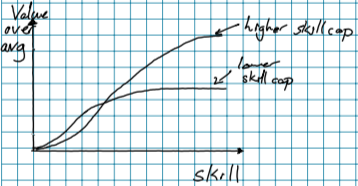EDIT: I'm only going to answer a few more questions, due to time constraints. I might eventually come back and answer more. I still appreciate getting replies with people's thoughts on things I've written.
I'm going to do an AMA on Tuesday next week (November 19th). Below I've written a brief description of what I'm doing at the moment. Ask any questions you like; I'll respond to as many as I can on Tuesday.
Although I'm eager to discuss MIRI-related things in this AMA, my replies will represent my own views rather than MIRI's, and as a rule I won't be running my answers by anyone else at MIRI. Think of it as a relatively candid and informal Q&A session, rather than anything polished or definitive.
----
I'm a researcher at MIRI. At MIRI I divide my time roughly equally between technical work and recruitment/outreach work.
On the recruitment/outreach side, I do things like the following:
- For the AI Risk for Computer Scientists workshops (which are slightly badly named; we accept some technical people who aren't computer scientists), I handle the intake of participants, and also teach classes and lead discussions on AI risk at the workshops.
- I do most of the technical interviewing for engineering roles at MIRI.
- I manage the AI Safety Retraining Program, in which MIRI gives grants to people to study ML for three months with the goal of making it easier for them to transition into working on AI safety.
- I sometimes do weird things like going on a Slate Star Codex roadtrip, where I led a group of EAs as we travelled along the East Coast going to Slate Star Codex meetups and visiting EA groups for five days.
On the technical side, I mostly work on some of our nondisclosed-by-default technical research; this involves thinking about various kinds of math and implementing things related to the math. Because the work isn't public, there are many questions about it that I can't answer. But this is my problem, not yours; feel free to ask whatever questions you like and I'll take responsibility for choosing to answer or not.
----
Here are some things I've been thinking about recently:
- I think that the field of AI safety is growing in an awkward way. Lots of people are trying to work on it, and many of these people have pretty different pictures of what the problem is and how we should try to work on it. How should we handle this? How should you try to work in a field when at least half the "experts" are going to think that your research direction is misguided?
- The AIRCS workshops that I'm involved with contain a variety of material which attempts to help participants think about the world more effectively. I have thoughts about what's useful and not useful about rationality training.
- I have various crazy ideas about EA outreach. I think the SSC roadtrip was good; I think some EAs who work at EA orgs should consider doing "residencies" in cities without much fulltime EA presence, where they mostly do their normal job but also talk to people.


FWIW, I could probably be described as a "skeptic" of updateless decision theories; I’m pretty sympathetic to CDT. But I also don’t think we should build AI systems that consistently take the actions recommended by CDT. I know at least a few other people who favor CDT, but again (although small sample size) I don’t think any of them advocate for designing AI systems that consistently act in accordance with CDT.
I think the main thing that’s going on here is that academic decision theorists are primarily interested in normative principles. They’re mostly asking the question: “What criterion determines whether or not a decision is ‘rational’?” For example, standard CDT claims that an action is rational only if it’s the action that can be expected to cause the largest increase in value.
On the other hand, AI safety researchers seem to be mainly interested in a different question: “What sort of algorithm would it be rational for us to build into an AI system?” The first question doesn’t seem very relevant to the second one, since the different criteria of rationality proposed by academic decision theorists converge in most cases. For example: No matter whether CDT, EDT, or UDT is correct, it will not typically be rational to build a two-boxing AI system. It seems to me, then, that it's probably not very pressing for the AI safety community to think about the first question or engage with the academic decision theory literature.
At the same time, though, AI safety writing on decision theory sometimes seems to ignore (or implicitly deny?) the distinction between these two questions. For example: The FDT paper seems to be pitched at philosophers and has an abstract that frames the paper as an exploration of “normative principles.” I think this understandably leads philosophers to interpret FDT as an attempt to answer the first question and to criticize it on those grounds.
I would go further and say that (so far as I understand the field) most academic decisions theorists aren't at all oriented by this question. I think the question they're asking is again mostly independent. I'm also not sure it would even make sense to talk about "using" a "decision theory" in this context, insofar as we're conceptualizing decision theories the way most academic decision theorists do (as normative principles). Talking about "using" CDT in this context is sort of like talking about "using" deontology.
[[EDIT: See also this short post for a better description of the distinction between a "criterion of rightness" and a "decision procedure." Another way to express my impression of what's going on is that academic decision theorists are typically talking about critera of rightness and AI safety decision theorists are typically (but not always) talking about decision procedures.]]